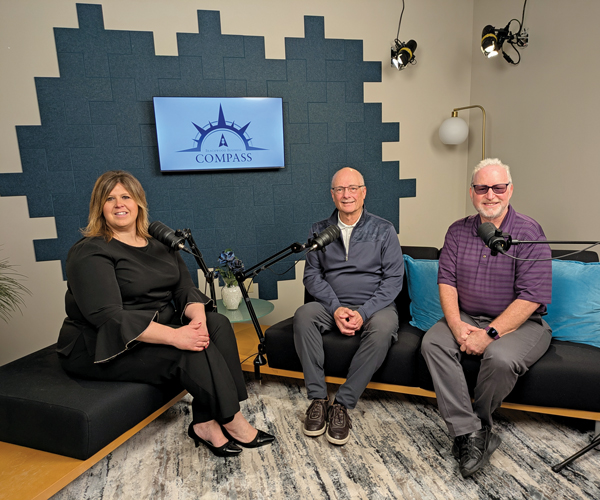"Anyone can hold the helm when the sea is calm."
The face of leadership in Cleveland is changing as more longstanding and trusted names are moving on to the next stages of their lives. We are also living through challenging times. The men and women at the head of our business, government and community sectors are tasked with solidifying their roles, developing their vision and mapping our way forward.
That quote by Roman writer Publilius Syrus is the perfect reflection about the different challenges of leadership during significant changing times or times of crisis and when there are no waves.
But if that quote sounds too lofty for your tastes, maybe this often repeated saying (told with many variations) is more relevant to you: “A leader is someone who is being run out of town, but makes it look like they are leading the parade.”
That is a bit like leadership in Cleveland during this time of marked changes in the political, civic, business, social, arts and educational arenas. Maybe now is not quite a tsunami, but it’s definitely a time to hold tight to the ship’s wheel. Do leaders need different skills and personality traits to be effective in changing times? Where are Cleveland’s emerging leaders coming from and are there both intentional and accidental leaders? And maybe most important of all, can Northeast Ohio’s leaders make the region as competitive as it should be now and in the future? Lessons can be found in the past.
“One hundred years ago, Cleveland was a city built on metal-bending, materials and chemicals,” says Tom Sudow, director, Burton D. Morgan Center for Entrepreneurial Studies, Ashland University. “The leaders felt very comfortable, and they didn’t see any need for change. In the early 1900s, Henry Ford came to Cleveland and was told by the leaders of the day that horseless carriages were really only a rich person’s game. So the auto industry grew up in Detroit instead.
“In the 1950s and 1960s, Silicon Valley was just a wilderness with tumbleweeds. Cleveland had a lot of early technology and could have been Silicon Valley. But Cleveland didn’t have the leadership that said we could do it. A leader has to be someone who is not comfortable, looks to the future and sells his or her vision.”
Sudow says some leaders lead by bully pulpit because “they either have position of power or they have resources they can use to force others to follow.” However, in most cases, “a good leader builds consensus, understands a problem and moves forward,” he adds.
“A great leader makes it a time of change. He or she says, ‘This is where the world is going, this is where we are going, and I have to get in front of it before anyone else does,’” explains Sudow.
He says he believes great leaders must be good listeners, especially if they are facing resistance. That resistance, he says, may be rooted in tradition or ritual, and followers are often set in their ways.
“You have to have people on your team who are risk-takers like you are,” advises Sudow.
“The traditions of the 50s, 60s, 70s and 80s are gone. The whole business of leadership has changed,” agrees Stephen Hoffman, chairman of the board of trustees for the Jack, Joseph and Morton Mandel Foundation. “The whole nature of business leadership has changed. Cleveland’s corporate structure has changed from the domination of very big companies like Eaton Corp., Sherwin-Williams and Progressive (Insurance), as well as other entrepreneurs.”
Hoffman points to the changing roles of university presidents who now “must be more than an academic with a great record and organizational skills.” Leaders of educational institutions must have an engaging personality, a sincere interest in people and not be afraid to ask for funding, he says.
“If some place doesn’t have that kind of leader now, it will starve to death,” says Hoffman.
Marianne Crosley has been the president and CEO of the Cleveland Leadership Center since 2010. Crosley says the pandemic “instilled a tremendous amount of fear in people, and everyone looked to the leaders.” Crosley also says that “in normal times, leadership is lonely.”
“But what leaders faced at the onset of the pandemic was tremendously lonely because there was no plan, no path,” she adds. “But I saw leaders leaning into one another. Maybe before they didn’t want to show their vulnerability to others, but they immediately did so because they needed to link arms and work together.”
Crosley says, “quiet partnerships,” like those formed by Cleveland’s healthcare systems, “helped keep people healthy both mentally and physically.” She also praises Cleveland’s neighborhood development corporations and Greater Cleveland Food Bank for mobilizing mobile vaccine units and food distribution where they were needed most.
“This pandemic was more than how we reacted with great tech tools and working remotely. It’s about how we were humbled, taken to our knees and how we reacted. How do we hold onto that empathy and compassion of great leaders that we saw?” Crosley asks.
Grace Gallucci is the executive director and CEO of the Northeast Ohio Areawide Coordinating Agency (NOACA), which represents five counties, 61 cities, 45 villages and 58 townships. That area covers 2,000 square miles and 2.1 million people. Gallucci, too, is hoping Northeast Ohio retains and grooms empathetic leaders who are also flexible and well-rounded to deal with today’s world.
“I have one concern with leadership in Cleveland, and it’s a concern found all over the country. Baby boomers have held onto leadership positions for a long time, and now it’s transitioning to millennials,” says Gallucci. “But a lot of people are forgetting that there is actually a Gen X generation between the boomers and the millennials. A lot of times they are not being included in leadership participation. I think going right from baby boomers to millennials without Gen X at the table doesn’t complete the entire picture for preparing yourself for the future.
“Baby boomers were the largest generation, and the millennials are their grandchildren. Grandparents typically spend more time with their grandchildren than they do with their own children. If you look at it in that context, it’s pretty easy to understand. It’s a pretty strange phenomenon. And it’s a lost opportunity. But it’s probably not too late to make sure Gen X leaders are included.”
Gallucci says changes in work styles and healthier lives among boomers allowed them to lead longer than in the past. Also, she says she believes Gen Xers were raised “more as followers and to wait their turn.”
“Millennials didn’t follow that idea as much, which in some ways, can be an advantage to them. They seize upon opportunities and make themselves known,” she says.
Of course, even the most visible of established or emerging leaders might not get the recognition they deserve. Gallucci says she believes former Mayor Frank Jackson did not get enough credit for “being a true leader, because much of what he did was not for the credit, but the outcome.”
Stephen Sokany is the board of directors’ co-president for the Museum of Contemporary Art (moCa) Cleveland. Sokany lists Audra Jones, moCa’s first African American board co-president, as having qualities he sees necessary to be an effective leader in Cleveland’s art community today, including being “cognizant, nimble, authentic and open and welcoming to everyone.”
MoCa has also initiated an institutional residency pilot with the Museum of Creative Human Art (MCHA) designed to support emerging artists and neighbor art leaders in Cleveland. Sokany sees MCHA’s co-founders Michael Russell II and Antwoine Washington as impressive leaders for their efforts. To be an effective leader, Russell says, “You must rid yourself of titles and have a passion to inspire and empower others.”
A long debatable question is whether leaders are born or made. Legendary football coach Vince Lombardi was sure leaders “are made just like anything else — through hard work.” That, he said, “is the price we’ll have to pay to achieve that goal or any goal.” But others think leaders are born or can be the result of both.
Gallucci says she believes most people “either want to be a leader or don’t.” She also thinks some individuals show leadership qualities as children, but may not get the opportunities to develop those skills. Also, people who become CEOs easily get branded as leaders, but others “who are great leaders of their families or hiking club may not get that recognition,” she says.
“Does learning leadership skills make you a leader? Not necessarily. But you certainly need those skills to be a better leader or manager. I don’t think there is anything people can’t learn if they want to,” adds Gallucci.
Hoffman says “an organized way to understand the environment in which you live” plus emotional intelligence (both vital factors for leaders) “can be coached if the basics are there and someone has role models.”
“Mort Mandel often expressed admiration for the leaders who came before him,” Hoffman says of his organization’s founder. “He looked up to business people and those actively engaged in philanthropy. He modeled himself after them in terms of their values, the way they treated people and cared about the issues. Then he added his unique perspective. That can be taught.”
A good leader is someone who is thinking two or three moves ahead, like a chess player, points out Sudow, who says someone can be taught that skill. But all leaders — born or created — must be good listeners, have the ability to rally their ideas and followers and articulate those ideas in ways that become attractive.
Of course, there is a dark side to leadership as well.
“There are also people who are great leaders, but do you really want to follow them off the cliff?” asks Gallucci.
“We don’t have all of the answers to leadership questions,” admits Hoffman. “But we know that the need for partnerships of leaders and leading organizations here is more important than ever before. When that’s lacking, Cleveland will stumble. But at the end of the day, we are optimistic here. We never give up.”
Leadership Education
Cleveland’s educational institutions and corporations offer a variety of leadership courses, programs and seminars. Here’s a sampling, but be sure to confirm programs because of possible changes due to the COVID-19 pandemic.
The Anti-Defamation League (ADL) Glass Leadership Institute is designed to give young professionals a personal view of the programs, policies and expertise of this civil rights and anti-hate organization.
CWRU Weatherhead School of Management offers undergraduate, MBA and specialty master’s degrees.
Cleveland Clinic Foundation — Samson Global Leadership Academy provides networking, coaching, communication skills training, management techniques, etc., for healthcare executives, physicians, nurses and administrators who are or want to be senior executives.
Cleveland Leadership Center offers these key programs providing collaborative leadership training and civic education: Look Up to Cleveland – high school; Campus Cleveland – college students; OnBoard Cleveland – early-career; Cleveland Bridge Builders – midcareer; Leadership Cleveland and LC2 Fellows – senior-level; Advanced Leadership Institute – multigenerational; and Legacy Leaders – retirees.
Cleveland State University/Center for Educational Leadership is designed to move individuals from teacher to principal to superintendent.
Cuyahoga Community College offers a variety of competency-based leadership development certificates and courses.
First Ring Leadership Academy engages teacher leaders in the 16 school districts surrounding Cleveland Metropolitan School District.
Hispanic Alliance Leadership Development and Initiative (HALDI) aims to develop Hispanic leadership in Cleveland by discussing key management tools and problem solving with members of the community.
Women for Economic Leadership Development (WELD) offers established women entrepreneurs and emerging professionals networking opportunities, as well as corporate board, government and commissions board training and more.
Neighborhood Leadership Institute partners with the Maxine Goodman Levin College of Urban Affairs at Cleveland State University to help participants understand community organizing, policy and advocacy, research and funding for projects, equity versus equality and more.
The Jack, Joseph and Morton Mandel Foundation offers a number of programs including:
• Community Development Corporation Leadership
Program — targets existing and future staff and board leaders of community development corporations in Cleveland; initiated September 2021
• Mandel Institute for Nonprofit Leadership — strengthens the capacities of professionals who lead or have potential to lead vital nonprofit institutions
• Neighborhood Leadership Development Program — cultivates diverse leadership abilities of Cleveland residents committed to creating a city that benefits everyone




